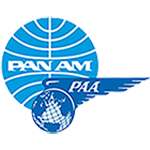SEPTEMBER 1934
"Crosson to Russia"

Photo Joe Crosson and Pacific Alaska Fairchild 71 (SDASM Archives, https://www.flickr.com/photos/sdasmarchives/8068574121/in/album-72157631732765977/)
When Pan Am’s B-707 Clipper Stargazer, landed in Moscow on July 15, 1968, most people were likely to remark on what they thought was the first time an American airline had operated a flight to what was then the Soviet Union.
It was understandable - but wrong. Pan Am’s first official USSR flight had come decades earlier.
On September 3, 1934, a single-engine Fairchild F-71, owned by Pan Am subsidiary Pacific Alaska Airways and piloted by legendary Alaskan aviator Joe Crosson, had crossed the waters dividing the US and Siberia with several official passengers and a bit of mail. The mission involved exploring the potential for a hoped-for air bridge between the two countries, and the practical beginnings of a direct westward route from the New World to Asia.
When the hardy little Fairchild left Nome, Alaska bound for Anadyr, Siberia it carried Assistant US Postmaster General Harlee Branch; Robert Thatch, senior Pan Am executive from New York; Lyman Peck, Pacific Alaska Airways Manager; and radio operator Bob Gleason.
At the time, the flight barely received public notice. As an aviation milestone, it didn’t rate much attention. The 180-mile flight took under two hours. But in terms of international significance, it rated as something significant.
1934 was the year that the United States was finally coming around to recognizing that the Soviet Union was a fact of life. For years, since the end of the bitter and violent civil war that followed the Russian Revolution, the US had refused to officially recognize the USSR. In 1934,the two nations were finally going to exchange ambassadors.
For American aviation, and Pan American in particular, the opening of relations with the Soviets meant that there could be a reasonable chance to establish a Great Circle route to Asia. The air route from Alaska to Siberia, and thence southward, could lead to a air connection with China, where Pan Am had already established a foothold with the acquisition of Curtiss-Wright’s minority stake in the China National Aviation Corporation (CNAC) the previous year. And two years before that, Pan Am had subsidized the pioneering survey flight by Charles and Anne Lindbergh, who explored the aerial path to China via Alaska and Japan.
The significance of Crosson’s mission was not lost on those who saw the big picture. Lauren Lyman, Aviation reporter for the New York Times commented in an article published the following week:
”Such a [Great Circle route] service would link up North America, Asia and Europe with a continuous air line without a single broken link more than five-sixths of the way around the northern half of the earth. It would extend the present far-flung air routes of Pan American from Buenos Aires to Siberia, save for the lines connecting within the United States and Canada.”
Sources:

